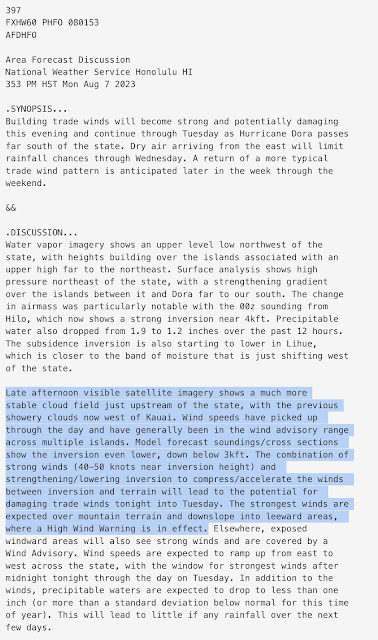It's just after noon on Saturday with a very eventful 60 hours or so on tap for SoCal, Nevada, and possibly portions of adjoining states due to one of the more significant tropical cyclone events in recent memory for the southwest US.
According to the latest (12 PM MDT Saturday August 19), Hurricane Hilary is currently a category 3 hurricane with 115 mph winds. Satellite imagery showed the circulation center of Hilary just west of the southern tip of Baja California with high clouds extending northward across Baja, SoCal, Nevada, and even northern Utah.
 |
| Source: College of DuPage |
Beneath those high clouds is a predecessor monsoon surge that is working its way up the lower Colorado River Valley and environs. Radar imagery at 1200 MDT (1800 UTC) Saturday showed showers and thunderstorms in southwest Arizona and southeast California. The heaviest were near and within an area with precipitable water values at or above 50 mm (2 inches).
Precipitable water is a measure of the total integrated water vapor content of the atmosphere with height, expressed as a depth if the vapor were condense. Values in excess of 60 mm (2.35 inches) are very close to Yuma where upper-air sounding records extend back to 1955 and the highest observed is 2.33 inches.
This is a juicy airmass and it is going to get juicier!
The National Hurricane Center calls for Hilary to track northward across northern Baja, SoCal, and central Nevada. Winds are expected to weaken to tropical storm strength when it crosses into SoCal and then further as it moves into Nevada, but most of the impacts will be due to precipitation and flooding.
 |
| Source: NHC, Issued 12 PM MDT Aug 19, 2023 |
Thus, don't be fooled by language like Hilary being downgraded or weakening. That pertains solely to the strength of the maximum sustained winds. The potential for serious flooding and even some wind damage in some areas remains.
To the former, check out the GFS total accumulated precipitation forecast from 1200 UTC 19 August (this morning) through 0000 UTC 22 August (6 PM MDT Sunday). More than 2 inches with locally greater accumulations across portions of SoCal and south-central Nevada and local accumulations around 5 inches.
 |
| Source: TropicalTidbits |
And these are remarkably dry areas. The GFS is putting out 4" for Death Valley, for example, which averages 2.24" a year.
The HRRR isn't quite as excited, but is still generating widespread 1-2.5+" for much of SoCal into south-central Nevada. A few high elevation areas are well over 5".
I plucked out the HRRR forecast for near Furnace Creek and it's just over 2.5".
And for Mount San Jacinto west of Palm Springs its 12.5+ inches, I think. I say I think because my code wasn't design to handle these outrageous totals so things are being plotted completely off scale.
The NWS forecast is for 5-7" in the Mount San Jacinto area, but also enormous totals of 4-5" in Palm Springs which is approaching their average annual precipitation of about 5.5".
 |
| Source: NWS; Issued 4:33 AM PDT 19 August |
This storm will come hard and fast. I don't really have an analog in my mind for it. It's probably good the storm is moving rapidly so that the intense precipitation doesn't linger for another day or two.
























.png)















